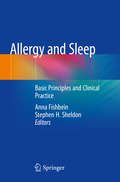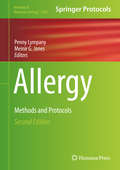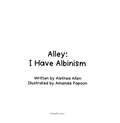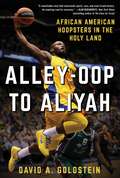- Table View
- List View
Allergy and Immunotoxicology in Occupational Health (Current Topics in Environmental Health and Preventive Medicine #0)
by Takemi Otsuki Claudia Petrarca Mario Di GioacchinoThis book offers a collection of the latest clinical and research findings related to allergies, one of the most frequently treated conditions in occupational medicine. The chapters not only cover asthma but also elaborate on contact dermatitis, rhinitis, and other allergic conditions, providing readers with a comprehensive overview of the substances disrupting autoimmunity and their effects on the human body. Allergy and Immunotoxicology in Occupational Health is a valuable resource for professionals and researchers in the occupational health sector, who will discover novel insights into immune effects, providing a foundation for future considerations of the health impairments caused by environmental and occupational exposure to these substances.
Allergy and Immunotoxicology in Occupational Health - The Next Step: The Next Step (Current Topics in Environmental Health and Preventive Medicine)
by Takemi Otsuki Claudia Petrarca Mario Di GioacchinoThis book presents a collection of the latest clinical and research findings in the field of allergy and immunotoxicology, covering the allergic responses to various nanoparticles and nanomaterials, posttreatment immune reconstruction, and monitoring the workplace environment. Following on from its acclaimed predecessor, the book provides readers with novel insights into immune effects, autoimmune diseases, and the immunotoxicity of various substances, such as silica and asbestos. Allergy and Immunotoxicology in Occupational Health - The Next Step invites readers in the occupational health sector to reflect on critical yet unresolved questions, and provides a foundation for future research on the health impairments resulting from environmental and occupational exposure to these substances.
Allergy and Respiration (Advances in Experimental Medicine and Biology #921)
by Mieczyslaw PokorskiAllergy is an increasing health issue. It often targets the respiratory tract and entwines with respiratory ailments, which makes it difficult to discern the cause-effect linkage. Nonetheless, measures to counter the allergic background are a linchpin in preserving respiratory health. This book is an update on current advances in clinical and basic science on allergy and related topics. The diagnostics of allergy requires a multidisciplinary approach, including molecular examinations aimed at unraveling the intracellular control cascades. Chapters give insight into the innovations concerning modern pulmonary function tests, discuss pharmacological paradigms, and tackle the overlapping infectious aspects and clinical symptoms and markers. Environmental and genetic factors elicit a spectrum of inflammatory phenotypes linked to differential body responses to allergic perturbations. The book is intended for healthcare professionals, notably pulmonologists, primary care physicians, and medical researchers.
Allergy and Sleep: Basic Principles and Clinical Practice
by Anna Fishbein Stephen H. SheldonSleep-related abnormalities occurring as a result of allergic disorders can impact an affected individual’s health and overall well-being in a myriad of ways. This comprehensive book thoroughly covers the management of allergic and sleep disorders, providing a detailed discussion on how these co-occurring, often overlapping conditions can be treated in a personalized and patient-oriented manner. Allergy and Sleep: Basic Principles and Clinical Practice takes care to include a wide range of multidisciplinary perspectives required to effectively assess and manage allergy and sleep disorders, from allergists, sleep medicine specialists, otolaryngologists, and dermatologists, to primary care physicians, pharmacists, psychologists, and other researchers. Allergy and Sleep begins with a thorough grounding on the science of sleep, allergy, immunology, circadian rhythms and circadian immunology. Part II addresses assessment and treatment of common allergic diseases with comorbid sleep components, in a practical, easy-to-use case-based format. Later sections closely examine sleep-related disturbances commonly associated with asthma, allergic rhinitis, and atopic disease; providing treatment guidelines, and detail various approaches to management throughout the patient’s lifespan. This resource concludes with a review of disease, sleep and circadian-specific therapeutics. Written by experts in their respective fields, Allergy and Sleep: Basic Principles and Clinical Practice is an ideal resource and important reference for any clinician working with patients suffering from sleep-related abnormalities due to allergic disorders.
Allergy-Free Desserts: Gluten-free, Dairy-free, Egg-free, Soy-free, and Nut-free Delights
by Elizabeth GordonSafe ways to sweeten the day for people with food allergiesSome twelve million Americans suffer serious allergic reactions to nuts, dairy, gluten, and other ingredients typically found in desserts. Finally, here's a collection of delicious dessert recipes offering a safe option for allergy sufferers who don't want to give up their favorite treats. Even though these recipes are completely free of gluten, dairy, nuts, soy, and eggs, you'll hardly notice the difference. Allergy-free Desserts includes recipes for all of your favorite baked treats—cakes, cupcakes, pies, quick breads, cookies, and dessert bars. Written by Elizabeth Gordon, herself allergic to eggs and wheat, this indispensable cookbook will finally let you enjoy desserts safely again. Featuring 82 recipes and 44 full-color photos Recipes that taste just like the real thing—but without the gluten, dairy, nuts, soy, or eggs The perfect dessert cookbook for the millions of people who suffer from food allergies or Celiac DiseaseAllergies shouldn't hold you back. Allergy-free Desserts finally lets you indulge your sweet tooth.
Allergy-Free Gardening
by Thomas L. OgrenWith allergy problems reaching epidemic levels, horticulturist Tom Ogren set out to investigate the role that urban landscaping plays in this health crisis. What he discovered was startling: The vastly disproportionate cultivation of all-male plant varieties produces large amounts of intensely irritating airborne pollen. This extensively researched reference helps gardeners and landscapers make landscaping choices that can drastically reduce their exposure to harmful allergens.
Allergy-Free Kids: The Science-Based Approach to Preventing Food Allergies
by Robin Nixon PompaBased on recent groundbreaking studies that will change the way parents feed their children, Allergy-Free Kids is a revolutionary guide to preventing food allergies.When her infant daughter was diagnosed with life-threatening food allergies, Robin Nixon Pompa found Dr. Gideon Lack, a clinical researcher on the verge of a breakthrough in allergy prevention and treatment that would heal her daughter and, later, her sons.The secret: building acceptance of allergens through repeated careful feedings. Instead of avoiding eggs, nuts, and other allergens, as previous recommendations held, most parents should introduce them into their children’s diets, "early, carefully and often, for at least the first five years of life." This life-changing approach is being embraced by the medical community, especially for peanut allergy, and is reflected in new guidelines from the American Academy of Allergy, Asthma and Immunology, the National Institutes of Health and other major medical associations.Allergy-Free Kids includes a concise, easy-to-understand overview of the research as well as seventy simple and delicious kid-friendly recipes to help parents integrate unfamiliar allergen foods into a child’s diet. Divided by allergen, Allergy-Free Kids contains sections on Eggs, Peanuts and Tree Nuts, Cow’s Milk, Sesame, Wheat and Fish. It also discusses other foods, such as kiwi and soy, which are increasingly causing allergic reactions. The book includes feeding advice, and maintenance doses, followed by recipes suitable for babies, toddlers and preschoolers, including Open Sesame Sweet Potatoes, Nut Flour Crackers, Cocoa "Puffs" and Eggs-Pretending-to-be-Muffins. Following the new medical guidelines, Allergy-Free Kids empowers parents to help their kids avoid a lifelong struggle with food allergies—and bring variety and joy back to family meals.
Allergy-Free and Easy Cooking: 30-Minute Meals without Gluten, Wheat, Dairy, Eggs, Soy, Peanuts, Tree Nuts, Fish, Shellfish, and Sesame
by Cybele PascalA collection of 75 completely allergen-free recipes ready in 30 minutes or less, perfect for food allergic kids and busy professionals who need to get meals on the table swiftly.Recipes for 75 everyday favorites ready in 30 minutes or less With her acclaimed cookbooks and loyal following, Cybele Pascal has been pioneering allergy-friendly cooking for more than a decade. As the mother of two kids with food allergies, Pascal knows the value of weeknight-friendly allergy-free recipes that can be prepped and on the table in half an hour without sacrificing flavor or texture. Through adept ingredient substitutions and easy-to-follow techniques, Pascal excels at providing enticing recipes that steer clear of the top eight allergens and appeal to home cooks who need to avoid dairy, eggs, wheat, soy, peanuts, tree nuts, fish, shellfish, and sesame. Pascal's allergy-friendly versions of favorites like Creamy Mac 'n' "Cheese," Buffalo Wings with Ranch Dressing, Chicken Mole Soft Tacos, Gnocchi, Deep Dish Pizza with Italian Sausage, and Beef and Broccoli Stir-Fry have all the appeal of the originals, and are perfect for food allergic kids and busy professionals. Allergy-Free and Easy Cooking is a delightful solution that will help you get flavorful, safe meals on the table swiftly.
Allergy: Methods and Protocols (Methods in Molecular Biology #2020)
by Penny Lympany Meinir G. JonesThis second edition volume expands on the previous edition with new insights into the molecular mechanisms involved in allergy through the use of various protocols that cover disciplines like allergy, immunology, cell biology, and histology. The chapters in this book cover topics such as characterization of allergens using western blotting and mass spectrometry, collecting and sampling airborne allergens, IgG antibodies, identification and characterization of allergen specific T cells, and the role of antigen presenting cells in T cell proliferation. Written in the highly successful Methods in Molecular Biology series format, chapters include introductions to their respective topics, lists of the necessary materials and reagents, step-by-step, readily reproducible laboratory protocols, and tips on troubleshooting and avoiding known pitfalls.Cutting-edge and thorough, Allergy: Methods and Protocols, Second Edition is a valuable resource for researchers interested in beginning or continuing their research in the study of allergies.
Allerleirauh: A Classic Grimm Fairy Tale Retelling
by Chantal GadouryFans of Melissa Meyer’s Heartless will adore this triumphant retelling of the classic Grimm Fairy Tale. “Allerleirauh is my new favorite read! Full of adventures, romance, and magic. You won't be disappointed when you grab a copy!” - The Book Nook Blog In the kingdom of Tranen, a king makes a promise to his dying wife that he'll only remarry a woman who possesses her golden hair. In time, the king's eyes are turned by his daughter. Realizing her father’s intentions, Princess Aurelia tries to trick him by requesting impossible gifts: dresses created by the sun, moon and stars, and a coat made of a thousand furs. But when he is successful, Aurelia sacrifices her privileged life and flees her kingdom, disguised by a cloak and a new name, Allerleirauh. She enters the safe haven of Saarland der Licht, where the handsome and gentle Prince Klaus takes her under his care. Hoping to remain undetected by her father’s courtiers, Allerleirauh remains hidden under her new identity when she finds unexpected love with Prince Klaus, even as his arranged marriage to the princess of a neighboring kingdom approaches. Risking everything, Allerleirauh must face her troubled past and her fears of the future in her journey to self-acceptance. *TW: Sexual Violence
Alleviating Poverty Through Profitable Partnerships 2e: Globalization, Markets, and Economic Well-Being
by Patricia H. Werhane Lisa H. Newton Regina WolfePoverty is an unnecessary form of human degradation and badly conceived economics. Our thesis is that poverty can be reduced, if not eradicated, both locally and globally. But this will occur only if we change our shared narratives about global free enterprise, remind ourselves that poverty is a system, and conceive of poverty alleviation as a "bottom up" project. There is no "one size fits all" for poverty reduction. Rather, poverty is a system and must be addressed locally. It is our aim, as it is the aim of the United Nations, the World Bank, and many other organizations, to erase it from our vocabulary and from this planet. With a series of case studies that accompany each chapter, this book should assist readers in thinking about poverty alleviation from a number of perspectives, from bottom-up entrepreneurial projects, local-corporate ventures, with public-private partnerships, from focused philanthropy, with education and health care initiatives, and agriculture reforms in rural communities, all with creating a win-win for local and partnership individuals, organizations, and communities.. The book should be useful in various undergraduate and graduate courses on ethics, applied ethics. developing economic systems, and on poverty.
Alleviating Poverty Through Profitable Partnerships: Globalization, Markets, and Economic Well-Being
by Patricia H. WerhaneIn this book, the authors approach poverty alleviation from an atypical perspective. The thesis is that poverty can be reduced, if not eradicated, both locally and globally, but this will occur only if we change our shared narratives about global free enterprise, and only if we recalibrate our mindsets regarding how poverty issues are most effectively addressed. They argue that poverty amelioration cannot be effected by the traditional means employed during the last century—foreign aid from developed nations and/or from non-profit international organizations. Rather, the authors present evidence which demonstrates that a mindset embracing initiatives developed by global corporations in response to the poverty challenge is significantly more effective. Global companies can alleviate poverty by seizing market opportunities at the Base of the economic Pyramid (BoP) with the implementation of three key processes: moral imagination, systems thinking, and deep dialogue. This approach to alleviating poverty offers some powerful ideas backed by the support of some of the leading Business Ethics minds in the United States. These scholars, some of whom are on the author team, have created a book that is unique and provocative yet still ideal for courses at the undergraduate level.
Alleviating World Suffering: The Challenge of Negative Quality of Life (Social Indicators Research Series #67)
by Ronald E. AndersonThis is the first volume on the subject of the alleviation of world suffering. At the same time it is also the first book framing the fields of global socio-economic development, world health, human rights, peace studies, sustainability, and poverty within the challenge of alleviating suffering and improving quality of life. Both international studies and global development have become specialized and fragmented, whereas this work assembles all of these development fragments together in order to determine whether common ground exists to make headway in reducing global suffering. Leading experts in these various fields of development and suffering have been recruited worldwide to give scholarly assessments of the major human problems and how they can be successfully tackled.
Alley & Rex (Alley & Rex)
by Joel RossFans of Diary of a Wimpy Kid and Wayside School will love this first book in a new, off-the-wall middle grade series about two boys—one with the heart of a lion and the test scores of a baked potato, the other a shy boy genius in a bunny suit—finding their strengths and true friendship.Sixth-grader Alley Katz is innocently trying to help a bunch of kindergarteners when the burrito hits the fan. Literally. A burrito. A ceiling fan. A hail of beans. Now he has to get an A on his science test or he&’ll be transferred to the dreaded Steggles Academy. An A seems impossible! Alley is kind, intrepid, and well-liked, but for some reason he doesn&’t get graded on any of that. So the principal assigns a peer mentor to help: Rex, a fourth-grade genius who wears a bunny suit. Alley is totally in favor of both bunnies and fourth graders, but he doesn&’t need Rex. He has his own foolproof plan to ace the test. Still, Rex is determined to fulfill his duty as Alley&’s mentor—and he may need some help of his own. One boy needs to stay in school, the other needs to get through it. Can this odd couple save the day—and each other?
Alley I Have Albinism
by Alethea AllenWritten by Alethea Allen and illustrated by Amanda Papoon, this heartwarming children’s book introduces readers to Alley, an eight-year-old girl with albinism. Through her story, Alley shares her vibrant personality, love for art, dancing, and writing, while also explaining the challenges and unique aspects of living with albinism. Alley proudly embraces her differences, highlighting her resilience and the support of her family and friends. The book serves as an educational and uplifting tale, encouraging understanding, kindness, and self-acceptance.
Alley Life in Washington: Family, Community, Religion, and Folklife in the City, 1850-1970 (Blacks in the New World)
by James BorchertForgotten today, established Black communities once existed in the alleyways of Washington, D.C., even in neighborhoods as familiar as Capitol Hill and Foggy Bottom. James Borchert's study delves into the lives and folkways of the largely alley dwellers and how their communities changed from before the Civil War, to the late 1890s era when almost 20,000 people lived in alley houses, to the effects of reform and gentrification in the mid-twentieth century.
Alley Oops
by Janice Levy C. B. DeckerThis story relates the painful and embarrassing aftermath of name-calling and bullying from the perspective of the bully. J. J. Jax has been tormenting an overweight boy named Patrick, calling him Pig-Pen and Porky, to the point that Patrick is now afraid to go to school. Learning of his son's behavior, J. J.'s father lectures him to stop bullying Patrick. When that approach fails, Mr. Jax tries another tack and shares an experience he had as a youthful bully and the consequences he recently faced as a result of his actions. Touched by his father's words, J.J. reaches out to Patrick in a school arm-wrestling contest and experiences the "alley oops" moment of empowerment and self-esteem that comes from doing the right thing. Snappy dialogue highlights the harmful, lasting effects of bullying and the importance of finding common ground toward conflict resolution. Believable contemporary illustrations bring the story to life with expressive body language.
Alley Urchin (The Emma Grady Sagas)
by Josephine CoxFrom a &“born storyteller,&” a historical saga of a wrongly imprisoned woman&’s reunion with her child and the man she loves (Times & Citizen). It is 1870 and Emma Grady has spent seven years of servitude as a convict in Australia. Now, having earned her ticket-of-leave, she is held by chains of honor and friendship. Emma&’s loyalty to her kind and gentle employer Roland Thomas, and her unwillingness to desert fellow convict and beloved friend Nelly, prevent her from leaving. Yet Emma lives for the days when she will return to England, to face those who cheated and betrayed her. And to Marlow Tanner, the man she loves, and whose tragic child she lost. As Emma battles against adversity, she is unaware that in England the child she has given up for dead is being lovingly raised by Marlow&’s sister Old Sal. Will Emma ever be reunited with Marlow? And even if she finds him, will he still love her? Despite seemingly insurmountable obstacles, her love can never be denied, or forgotten. The breathtaking second novel of The Emma Grady Sagas Praise for the writing of Josephine Cox: &“Hailed quite rightly as a gifted writer in the tradition of Catherine Cookson&” —Manchester Evening News &“Cox&’s talent as a storyteller never lets you escape.&” —Daily Mail &“Driven and passionate.&” —The Sunday Times
Alley Urchin: A thrilling saga of love, resilience and revenge (Emma Grady trilogy, Book 2)
by Josephine CoxTo return to those she loves, she must also return to the past... In the second instalment of her Emma Grady trilogy, bestselling author Josephine Cox brings us Alley Urchin, a gripping saga of a woman determined to overcome the brutality of life as a convict to return to the man she loves. Perfect for fans of Kitty Neale and Rosie Goodwin.By 1870 Emma Grady has spent seven years of servitude as a convict in Australia. Emma lives for the day when she will return to England, to face those who cheated and betrayed her. And to Marlow Tanner, the man she loves - and whose tragic child she had borne and then lost.Emma struggles to make something of her life in Australia despite the sinister presence of her employer's evil son, Foster. His determination to 'have' Emma leads to dark and terrifying consequences. As Emma battles against adversity, she is unaware that in England the child she has given up for dead is being lovingly raised by Marlow's sister Old Sal, who teaches Emma's daughter Molly to be an expert pickpocket.Will Emma ever be reunited with Marlow? Even if she finds him, will he still love her? And what of the child lost to both of them? Emma is plagued with fears but her love for Marlow never weakens - and can never be forgotten... What readers are saying about Alley Urchin: 'Josephine Cox has the unique talent of writing books which provoke every emotion in the reader. This book in the Emma Grady trilogy has all this - and more. We feel for the characters as if we know them and, as with all Josephine Cox books, it is very hard to put down the book once started... You will find yourself impatient to get to the end!''Another great, thrilling book which keeps you guessing till the end. The story is well written with some great twists''Totally absorbing. Unputdownable!'
Alley Urchin: A thrilling saga of love, resilience and revenge (Emma Grady trilogy, Book 2)
by Josephine CoxTo return to those she loves, she must also return to the past... In the second instalment of her Emma Grady trilogy, bestselling author Josephine Cox brings us Alley Urchin, a gripping saga of a woman determined to overcome the brutality of life as a convict to return to the man she loves. Perfect for fans of Kitty Neale and Rosie Goodwin.By 1870 Emma Grady has spent seven years of servitude as a convict in Australia. Emma lives for the day when she will return to England, to face those who cheated and betrayed her. And to Marlow Tanner, the man she loves - and whose tragic child she had borne and then lost.Emma struggles to make something of her life in Australia despite the sinister presence of her employer's evil son, Foster. His determination to 'have' Emma leads to dark and terrifying consequences. As Emma battles against adversity, she is unaware that in England the child she has given up for dead is being lovingly raised by Marlow's sister Old Sal, who teaches Emma's daughter Molly to be an expert pickpocket.Will Emma ever be reunited with Marlow? Even if she finds him, will he still love her? And what of the child lost to both of them? Emma is plagued with fears but her love for Marlow never weakens - and can never be forgotten... What readers are saying about Alley Urchin: 'Josephine Cox has the unique talent of writing books which provoke every emotion in the reader. This book in the Emma Grady trilogy has all this - and more. We feel for the characters as if we know them and, as with all Josephine Cox books, it is very hard to put down the book once started... You will find yourself impatient to get to the end!''Another great, thrilling book which keeps you guessing till the end. The story is well written with some great twists''Totally absorbing. Unputdownable!'
Alley-Oop to Aliyah: African American Hoopsters in the Holy Land
by David A. GoldsteinEvery season, dozens of African American basketball players pack up their sneakers to play and live in Israel. They eat Israeli food, navigate Israeli hustle and bustle, experience cultural and religious customs in the world’s only Jewish country, and voluntarily expose themselves to the omnipresent threat of violence in the volatile Middle East. Some players are both Black and Jewish by birth. Others choose to convert to Judaism while residing in Israel. Some go so far as to obtain Israeli citizenship, enlist in the Israeli Army, marry Israeli women, and stay long after their playing careers end. Alley-Oop to Aliyah: African American Hoopsters in the Holy Land, is the first book to provide an in-depth exploration and analysis of the experiences of African American basketball players in Israel from the 1970s till today. Author David A. Goldstein examines how they end up in the country in the first place, the multitude of distinctive aspects of their lives there, the challenges and difficulties they face, and the reasons some choose to return to Israel year after year. In some cases they even decide to stay in Israel permanently. Alley-Oop to Aliyah not only deals with basketball and its impact on Israel, but it delves into emotion-laden issues of race, religion, identity, and politics, primarily through the eyes of the players themselves, based on more than forty extensive first-person interviews Goldstein, a sports journalist of half-Israeli descent, conducted. Their stories and their impact on Israel are at the very heart of this revealing book that is about more than just a game.
Allez Allez Allez: The Inside Story of the Resurgence of Liverpool FC, Champions of Europe 2019
by Simon Hughes_________'WE ARE LIVERPOOL - THIS MEANS MORE.' JÜRGEN KLOPPAllez Allez Allez is the inside account of Liverpool FC during the Klopp era, including the 2018/19 campaign which saw the club compete in the most gripping Premier League title race in history and become Champions of Europe for the sixth time.Featuring access to management, players and staff, Allez Allez Allez explains how Liverpool have emerged from what Jürgen Klopp described as the “depression” of 2015 to achieve feats that have eluded an entire generation of supporters.Through original research and exclusive interviews, Simon Hughes takes readers into Melwood, the club’s training ground, and behind the dressing room door. He takes them to Chapel Street, where the club’s business is determined, and to America, where it is owned. He takes them into Anfield, where many of the most important moments are defined, and he takes them on to the pitches of the Premier League and the Champions League, as we revisit how Liverpool stormed their way to the top of the Premier League this season.
Allhallow's Eve: A past massacre returns to haunt the present
by Richard LaymonEveryone wants to party in a house of death... Allhallow's Eve is a spine-chilling horror novel from Richard Laymon, perfect for fans of Stephen King and Dean Koontz.Nothing unusual ever happens in Ashburg until a local family are horribly mutilated and left to die in their own home. Since that night, the old Sherwood house has stood dark and abandoned - a constant reminder of the horrific killings. But when mysterious invitations begin to arrive, announcing a party to be held there, nobody thinks it's a joke. After all, on Allhallow's Eve everyone wants to party in a house of death... What readers are saying about Allhallow's Eve: 'A fast paced, gore filled, taboo ridden storyline''This book has everything, fear, anticipation and an excellent ending''One of the best books that Richard Laymon has ever written'
Alliana, Girl of Dragons
by Julie AbeFor fans of Shannon Hale and Gail Carson Levine, comes an enchanting fairy tale retelling of the Japanese Cinderella, set in the magical world of Eva Evergreen, Semi-Magical Witch.Once upon a time, Alliana believed in dreams and fairy tales as sweet as spun-sugar clouds. Alliana wished on shooting stars, sure that someday she and her grandmother would be able to travel to the capital city to see the queen. Then her grandmother passed away—and those dreams disappeared in a disenchanted puff. Now Alliana&’s forced to attend to the whims of her wicked stepmother—with long days of cleaning her stepfamily&’s inn as her skin burns raw or staying up until the crack of dawn to embroider her stepsister&’s ball gowns. Until she meets two beings who change her life forever—the first is a young nightdragon who Alliana discovers she can magically talk to. And the second is Nela, a young witch. Nela needs Alliana&’s help navigating the mysterious abyss, filled with dangerous beasts, a place Alliana knows by heart. Alliana sees Nela&’s request as a chance to break free of her stepmother&’s shadow and to seize a chance at a life she&’s barely dared to hope for—but there&’s a risk. If caught, Alliana will be stuck working for her stepmother for the rest of her life. Can Alliana truly make wisps of dreams into her own, better-than-a-fairy-tale happily ever after? Inspired by the Japanese Cinderella story and set in the same world as the Eva Evergreen series, this story can be read as a standalone.
Alliance
by Jonathan FenbyThe history of the Second World War is usually told through its decisive battles and campaigns. But behind the front lines, behind even the command centres of Allied generals and military planners, a different level of strategic thinking was going on. Throughout the war the 'Big Three' -- Churchill, Roosevelt and Stalin -- met in various permutations and locations to thrash out ways to defeat Nazi Germany -- and, just as importantly, to decide the way Europe would look after the war. This was the political rather than military struggle: a battle of wills and diplomacy between three men with vastly differing backgrounds, characters -- and agendas. Focusing on the riveting interplay between these three extraordinary personalities, Jonathan Fenby re-creates the major Allied conferences including Casablanca, Potsdam and Yalta to show exactly who bullied whom, who was really in control, and how the key decisions were taken. With his customary flair for narrative, character and telling detail, Fenby's account reveals what really went on in those smoke-filled rooms and shows how "jaw-jaw" as well as "war-war" led to Hitler's defeat and the shape of the post-war world.























